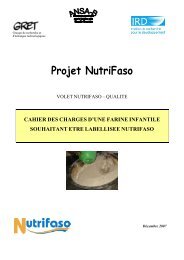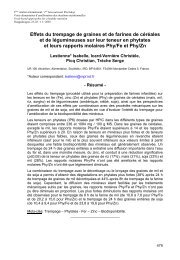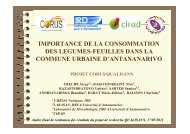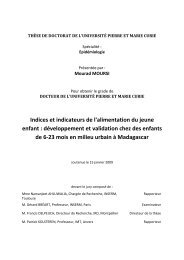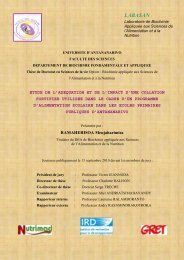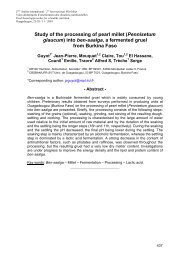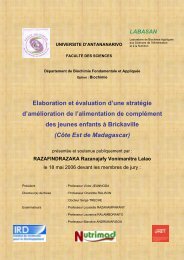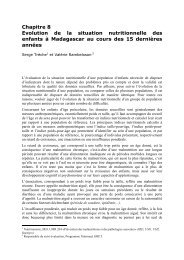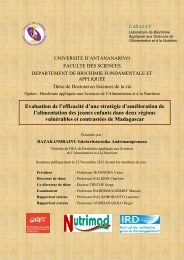THESE UNIQUE El Hassane Kéhien-Piho TOU - Nutridev
THESE UNIQUE El Hassane Kéhien-Piho TOU - Nutridev
THESE UNIQUE El Hassane Kéhien-Piho TOU - Nutridev
You also want an ePaper? Increase the reach of your titles
YUMPU automatically turns print PDFs into web optimized ePapers that Google loves.
Food Chemistry 100 (2007) 935–943<br />
Food<br />
Chemistry<br />
www.elsevier.com/locate/foodchem<br />
Effect of different process combinations on the fermentation<br />
kinetics, microflora and energy density of ben-saalga, a fermented<br />
gruel from Burkina Faso<br />
E.H. Tou a,b , C. Mouquet-Rivier a,b, *, I. Rochette c , A.S. Traoré b , S. Trèche c , J.P. Guyot c<br />
a UR 106 Nutrition, Alimentation, Sociétés, Institut de Recherche pour le Développement (IRD) 01 BP 182, Ouagadougou, Burkina Faso<br />
b CRSBAN, UFR-SVT, Université de Ouagadougou, 03 BP 7131, Burkina Faso<br />
c UR106 Nutrition, Alimentation, Sociétés, Institut de Recherche pour le Développement (IRD), BP 64501, F-34394, Montpellier, France<br />
Received 5 August 2005; received in revised form 1 November 2005; accepted 3 November 2005<br />
Abstract<br />
Three different processes combining cooking (C), addition of malt (M) and/or backslop inoculation (I) were investigated to increase<br />
the energy density (ED) of ben-saalga, a millet-based fermented gruel and their effects on fermentation kinetics and microbiological characteristics<br />
were assessed. In the process combining cooking and inoculation (CI) and in the control (traditional processing methods),<br />
glucose and fructose were the main sugars and their concentrations decreased during the settling step (fermentation). In the process combinations<br />
that included the addition of malt (CM and CMI), maltose was the main sugar that accumulated during settling. In the CM<br />
process combination, the start of fermentation was considerably delayed due to the marked reduction in natural microflora during cooking.<br />
In contrast, in the CI and CMI process combinations, inoculation by back slopping accelerated acidification, resulting in a pH value<br />
of below 4.0 after 7 h of fermentation. Although malt was added at a very low rate (0.125%), gruels made using CM and CMI process<br />
combinations, and prepared at a suitable consistency, had an ED close to or above 84 kcal/100 g of sweetened gruel, the minimum value<br />
required for complementary food.<br />
Ó 2005 <strong>El</strong>sevier Ltd. All rights reserved.<br />
Keywords: Pearl millet; Lactic acid fermentation; Sugars; Organic acids; Complementary food; Energy density; Malt<br />
1. Introduction<br />
Traditional cereal-based fermented foods, such as potopoto,<br />
ogi, kenkey and ben-saalga, are well accepted and<br />
widely consumed in Africa (Blandino, Al-Aseeri, Pandiella,<br />
Cantero, & Webb, 2003; Oyewole, 1997). Some of these<br />
traditional cereal-based fermented gruels are frequently<br />
used as complementary foods for infants and young children.<br />
However, they are characterized by a low energy<br />
and nutrient density (Lorri & Svanberg, 1994), well below<br />
the values recommended by Dewey and Brown (2003) for<br />
complementary foods. The consumption of high energy<br />
density (ED) gruels enables improvement of the infantÕs<br />
* Corresponding author. Fax: +226 50 31 03 85.<br />
E-mail address: claire.mouquet@ird.bf (C. Mouquet-Rivier).<br />
energy and nutrient intakes (Brown et al., 1995; Den Besten,<br />
Glatthaar, & Ijsselmuiden, 1998; Moursi, Mbemba,<br />
& Trèche, 2003; Vieu, Traoré, & Trèche, 2001).<br />
The ED of cereal-based gruels depends on their flour content.<br />
However, this flour content is limited by the thickening<br />
of the gruels due to the swelling of the starch during cooking,<br />
which results in gruels with low EDs. One of the ways to<br />
obtain a thin cereal-based gruel with a high ED is to achieve<br />
partial hydrolysis of the starchy fraction. The effect of natural<br />
fermentation on the viscosity of cereal-based gruels has<br />
already been assessed. It has been shown that natural lactic<br />
acid fermentation of cereal gruels has a slight viscosityreducing<br />
effect that cannot result in thin gruels with high<br />
ED (Lorri & Svanberg, 1993; Westby & Gallat, 1991).<br />
Different technological methods have been tested to<br />
increase the ED of fermented and unfermented<br />
0308-8146/$ - see front matter Ó 2005 <strong>El</strong>sevier Ltd. All rights reserved.<br />
doi:10.1016/j.foodchem.2005.11.007



